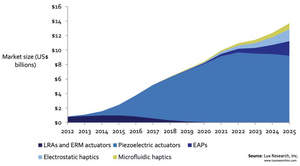BOSTON, MA--(Marketwired - Aug 6, 2013) - Driven by the global boom in consumer electronics, notably cellphones and tablet computers, the market for haptics -- which provide a tactile response to enhance user experience -- will soar over 16-fold to $13.8 billion in 2025, according to Lux Research.
The consumer electronics segment, which in 2012 comprised nearly all of the $842 million haptics market, alone will balloon to $12.3 billion, 89% of the total market, as OEMs look to enhance touchscreen devices. Smaller opportunities will emerge in sectors such as automotive, fitness and medical as a variety of touch technologies are added to enhance user experience.
"An emerging wave of haptics offers the potential for a more intuitive and information-rich touch experience than today's simple whole-device vibration," said Anthony Vicari, Lux Research Associate and the lead author of the report titled, "Getting Back in Touch with Electronics: Finding Opportunity in Emerging Haptics."
Lux Research analysts evaluated the haptic feedback technologies driving the proliferation of touch-enabled devices and their emerging applications. Among their findings:
- Piezoelectric actuator is the emerging technology of choice. Engineered to produce finely controlled vibrations across a broad range of frequencies, the piezoelectric actuator is poised to replace incumbent linear resonant actuators (LRAs) and eccentric rotating mass (ERM) to generate $9.2 billion in sales in 2025.
- Public interfaces form second-largest market. Public shared interfaces such as ATMs, information kiosks, touch-enabled vending machines, office copiers and even voting machines will form the second largest market worth $1.3 billion, behind consumer electronics.
- Surface coverage haptics will zoom after 2016. Surface coverage haptics like electroactive polymers, electrostatics, and microfluidics, offer a richer user experience by varying the touch sensation across the surface of the device. They have yet to be used in a commercial device, but will arrive in 2016 and then score quick gains, growing to a $4.5 billion market in 2025.
The report, titled "Getting Back in Touch with Electronics: Finding Opportunity in Emerging Haptics," is part of the Lux Research Printed, Flexible, and Organic Electronics Intelligence service.
About Lux Research
Lux Research provides strategic advice and ongoing intelligence for emerging technologies. Leaders in business, finance and government rely on us to help them make informed strategic decisions. Through our unique research approach focused on primary research and our extensive global network, we deliver insight, connections and competitive advantage to our clients. Visit www.luxresearchinc.com for more information.
Contact Information:
Contact:
Carole Jacques
Lux Research, Inc.
617-502-5314
carole.jacques@luxresearchinc.com
